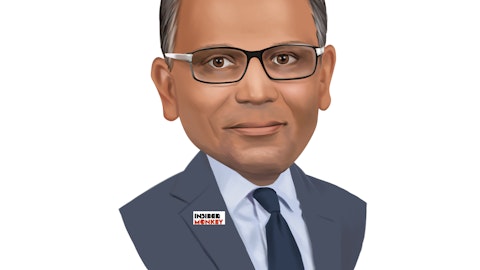Polen Capital, an investment management firm, published its “Polen International Growth” second quarter 2021 investor letter – a copy of which can be downloaded here. A return of 5.57% was delivered by the fund for the Q2 of 2021, outperforming its MSCI All Country World benchmark that delivered a 5.47% return for the same period. You can take a look at the fund’s top 5 holdings to have an idea about their top bets for 2021.
In the Q2 2021 investor letter of Polen Capital, the fund mentioned New Oriental Education & Technology Group Inc. (NYSE: EDU) and discussed its stance on the firm. New Oriental Education & Technology Group Inc. is a Haidian District, Beijing, China-based private educational services provider with a $3.4 billion market capitalization. EDU delivered a -89.20% return since the beginning of the year, while its 12-month returns are down by -86.26%. The stock closed at $2.03 per share on August 25, 2021.
Here is what Polen Capital has to say about New Oriental Education & Technology Group Inc. in its Q2 2021 investor letter:
“The leading absolute detractors from performance for the second quarter (includes) New Oriental Education. Shares of China-based after-school tutoring company New Oriental Education declined in the quarter. In our view, New Oriental’s competitive advantage stems from its brand strength, which is synonymous with teaching content, teacher quality, and the largest network of tutoring centers in China.
Communist Party leadership recently flagged the pressure exerted on Chinese youth, voicing an aim to reduce after-school homework and time spent with tutors. New Oriental Education shares moved lower as news of regulatory changes trickled into the market.
On a related note, China uses standardized tests to determine student placement into high school and college. The importance of these tests on a student’s career path is hard to overstate, and students spend significant time outside school preparing for these exams. These tests seem unlikely to be banned. As such, parents could continue seeking ways to improve their children’s chances of success on tests. Complete prohibitions on test prep seem unlikely and would force parents to seek tutoring in one-on-one settings, but restrictions on times allowed for tutoring are possible. As we write this letter, no formal central government policy has been announced.
Our belief is that increasing government scrutiny stems from a rush over the last two years of early-stage, online-only tutoring companies vying for market share, which they have pursued by aggressively advertising for parents to enroll their children in tutoring services. Some of these companies offered poor teaching content and services. We reasoned last quarter that New Oriental could sidestep policy changes since its business leans heavily on brick-and-mortar schoolhouses and less on the digital ad and internet-based model. It now looks like the whole tutoring space could be impacted.
We have seen examples of regulatory changes to an industry benefitting incumbent leaders. We do not know if that will prove true here and note that restrictions on digital advertising support those incumbents with brand resonance like New Oriental. Without tangible policy information, we do not want to speculate on what the industry will look like. However, we continue to believe New Oriental is competitively advantaged and offers a high-demand service in a large and growing market. When and if official policy changes, we will be able to better judge New Oriental’s growth trajectory.”

Photo by Jerry Wang on Unsplash
Based on our calculations, New Oriental Education & Technology Group Inc. (NYSE: EDU) was not able to clinch a spot in our list of the 30 Most Popular Stocks Among Hedge Funds. EDU was in 39 hedge fund portfolios at the end of the first half of 2021, compared to 45 funds in the previous quarter. New Oriental Education & Technology Group Inc. (NYSE: EDU) delivered a -80.42% return in the past 3 months.
Hedge funds’ reputation as shrewd investors has been tarnished in the last decade as their hedged returns couldn’t keep up with the unhedged returns of the market indices. Our research has shown that hedge funds’ small-cap stock picks managed to beat the market by double digits annually between 1999 and 2016, but the margin of outperformance has been declining in recent years. Nevertheless, we were still able to identify in advance a select group of hedge fund holdings that outperformed the S&P 500 ETFs by 115 percentage points since March 2017 (see the details here). We were also able to identify in advance a select group of hedge fund holdings that underperformed the market by 10 percentage points annually between 2006 and 2017. Interestingly the margin of underperformance of these stocks has been increasing in recent years. Investors who are long the market and short these stocks would have returned more than 27% annually between 2015 and 2017. We have been tracking and sharing the list of these stocks since February 2017 in our quarterly newsletter.
At Insider Monkey, we scour multiple sources to uncover the next great investment idea. For example, Federal Reserve has been creating trillions of dollars electronically to keep the interest rates near zero. We believe this will lead to inflation and boost real estate prices. So, we recommended this real estate stock to our monthly premium newsletter subscribers. We go through lists like the 10 best EV stocks to pick the next Tesla that will deliver a 10x return. Even though we recommend positions in only a tiny fraction of the companies we analyze, we check out as many stocks as we can. We read hedge fund investor letters and listen to stock pitches at hedge fund conferences. You can subscribe to our free daily newsletter on our homepage.
Disclosure: None. This article is originally published at Insider Monkey.




